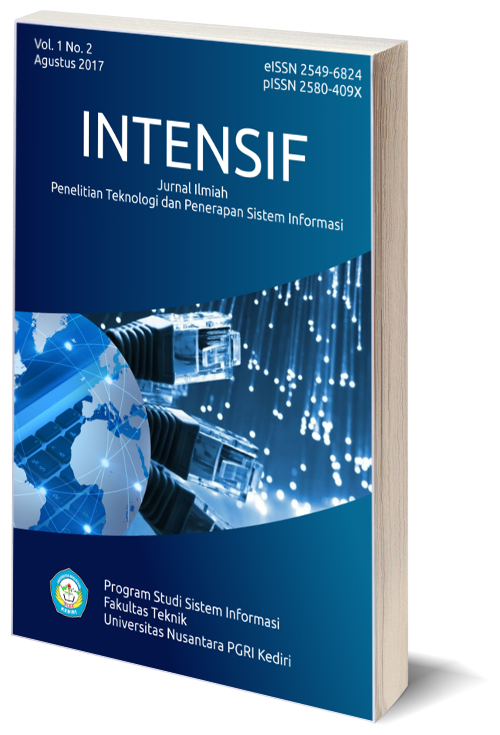Implementasi Metode Reynolds menggunakan Simulasi Kerumunan Bebek
DOI:
https://doi.org/10.29407/intensif.v1i2.788Keywords:
Metode Reynolds, Kerumunan, Bebek, BerjalanAbstract
"Simulation of Duck Crows Using Reynolds Method" is a study with the aim to find out the behavior of duck breeding crowd. The next goal is to make a crowd simulation using the Reynolds method. Limitations of this research variable is the object of research on adult duck Turi, the method used is Reynolds method. The simulations are made using Unity3D software in the form of 3D and the animation provided is just a running gesture. The method of analysis of this research is using research and development method. The result of the research is the data of duck walking in the crowd to be applied in 3D animation. The end result of the study is a simulation of duck crowds that run on flat fields. Destination directions are affected by mouse input and can avoid obstacles when walking. This simulation uses Reynolds basic rules of cohesion, alignment and separation.The conclusion of the research is that there is a similarity between the simulation of the crowd with the movement of the original duck crowd and the Reynolds method can be applied in the simulation of the duck crowd in 3D. Research produces 3D animation of duck crowds that are given the ability to avoid obstacles and target goals determined by mouse input.
Downloads
References
Eliyan and L. Fayez, ―Modeling Family Behaviors In Crowd Simulation Qatar University, 2017.<br>
L. Famukhit, Muga, M. Suyanto, and Sukoco, ―Simulasi Gerak Kepiting Menggunakan Metode Inverse Kinematics, J. Speed – Sentra Penelit. Eng. dan Edukasi, vol. 8, no. 2, 2016.<br>
S. Haryati, ―Research And Development (R&D) Sebagai Salah Satu Model Penelitian Dalam Bidang Pendidikan. Ilmiah Dinamika, vol. 37, no. 1, 2012.<br>
Hasan and M. Iqbal, Pokok-Pokok Materi : Teori Pengambilan Keputusan. Jakarta: Ghalia Indonesia, 2002.<br>
Kusumaningtyas and Pratiwi, Potensi Bisnis dan Kisah Suskes Praktisi. Jakarta: Agriflo, 2012.<br>
W. Li, D. Wolinski, J. Pettré, and Ming C Lin, ―Biologically-Inspired Visual Simulation of Insect Swarms, Comput. Graph. Forum c Eurographics Assoc. John Wiley Sons Ltd, vol. 34, no. 2, 2015.<br>
Mudhana, I. M. P., Purnomo, M. H., Nugroho, and S. M. S, ―Movement of the Tsunami Evacuation Simulation Using Boids and Pathfinding Algorithm, in Seminar Nasional ReTII 9, 2014, pp. 198–204.<br>
C. W. Reynolds, ―Boids : Flocking Behaviors For Autonomous Characters, 2016.<br>
Reynolds and W. Craig, ―Boids: Background and Update, 2016. [Online]. Available: http://www.red3d.com/cwr/boids/.<br>
R. Roedavan, UNITY : Tutorial Game Engine. Bandung: Informatika, 2016.<br>
M. Sajwan and S. S. Devashish Gosain, ―Flocking Behaviour Simulation : Explanation and Enhancements in Boid Algorithm, Int. J. Comput. Sci. Inf. Technol., vol. 5, no. 4, 2014.<br>
S. Sarmady, ―Modeling And Simulation Of Movement And Behaviors In Large Crowd Using Cellular Automata, Universiti Sains Malaysia, 2008.<br>
S. Sopiyana, A. R. Setioko, and M.E. Yusnandar, ―Identifikasi Sifat-Sifat Kualitatif Dan Ukuran Tubuh Pada Itik Tegal, Itik Magelang, Dan Itik Damiaking, in Pros. Lokakarya Nasional Inovasi Teknologi Dalam Mendukung Usaha Ternak Berdaya Saing, 2006.<br>
D. Thalmann and S. Musse, Crowd Simulation. London: Springer-Verlag, 2007.<br>
R. C. W, Flock, Herds, and Schools, ―A Distributed Behavioral Model, in Proceeding of SIGGRAPH, 2004.<br>
S. Wojowasito, Kamus Umum Lengkap. Bandung, 1997.<br>
D. Wolinski, ―Microscopic Crowd Simulation : Evaluation And Development Of Algorithms. Data Structures and Algorithms, Universit´e Rennes, 2016.<br>
Zulkarnain and I. Abdurrozaq, ―Simulasi Efek Tembakan Pada Manusia, STMIK AMIKOM Yogyakarta, 2017.</p>
Downloads
Published
Issue
Section
License
Authors who publish with this journal agree to the following terms:
- Copyright on any article is retained by the author(s).
- The author grants the journal, the right of first publication with the work simultaneously licensed under a Creative Commons Attribution License that allows others to share the work with an acknowledgment of the work’s authorship and initial publication in this journal.
- Authors are able to enter into separate, additional contractual arrangements for the non-exclusive distribution of the journal’s published version of the work (e.g., post it to an institutional repository or publish it in a book), with an acknowledgment of its initial publication in this journal.
- Authors are permitted and encouraged to post their work online (e.g., in institutional repositories or on their website) prior to and during the submission process, as it can lead to productive exchanges, as well as earlier and greater citation of published work.
- The article and any associated published material is distributed under the Creative Commons Attribution-ShareAlike 4.0 International License












